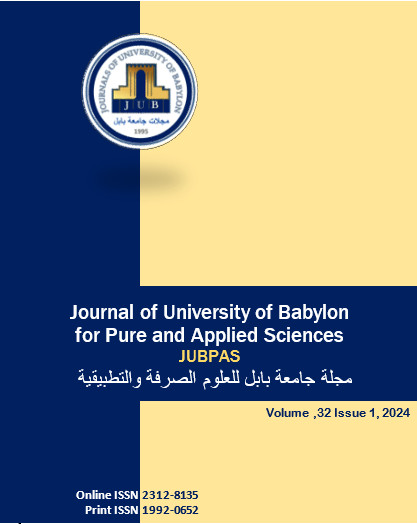Abstract
Background: The chance of camel thistle squander as eco-accommodating, accessible, and monetary adsorbent for adsorption methylene blue color from its watery arrangement was analyzed by utilizing clump and section framework. All experiments of the batch were achieving with modification camel thorn waste dye concentration 50 mg/L, pH6.5, Temp 25 oC.
Materials and Methods: Camel thorn (CT) waste were collected from AL-Mahaweel region, this region situated in Babylon city/Iraq. The waste were direct washed with running water tap to release all impurities, and rinsed with distilled water for 4 times, after then it dried under sunlight, and then in oven under 50 oC for two hours. The dried (CT) waste were ground and sieved BSS-60 mesh size particle
Results: Methylene Blue(MB) dye was examined to remove from the aqueous solution by adsorption on the camel thorn waste added to the acidic adsorbent modification, thermal adsorbent modification on the decolonization dye efficiency was studies were investigated with the similar working condition contact time (2-90 min).
Conclusion: The current discoveries created the impression that the that normal adsorbent, camel thistle squander is altogether appropriate for the depolarization of methylene blue color from its watery arrangement. The outcomes show that the balance isotherm for the two modules that utilized in this work are of good kind, for being curved vertical
Materials and Methods: Camel thorn (CT) waste were collected from AL-Mahaweel region, this region situated in Babylon city/Iraq. The waste were direct washed with running water tap to release all impurities, and rinsed with distilled water for 4 times, after then it dried under sunlight, and then in oven under 50 oC for two hours. The dried (CT) waste were ground and sieved BSS-60 mesh size particle
Results: Methylene Blue(MB) dye was examined to remove from the aqueous solution by adsorption on the camel thorn waste added to the acidic adsorbent modification, thermal adsorbent modification on the decolonization dye efficiency was studies were investigated with the similar working condition contact time (2-90 min).
Conclusion: The current discoveries created the impression that the that normal adsorbent, camel thistle squander is altogether appropriate for the depolarization of methylene blue color from its watery arrangement. The outcomes show that the balance isotherm for the two modules that utilized in this work are of good kind, for being curved vertical
Keywords
methylene blue dye
adsorption
camel thorn
Abstract
المقدمة: تم دراسة فرصة تبديد شوك الجمل كممتصات بيئية ، ويمكن الوصول إليها ، وممتازات نقدية لامتصاص اللون الأزرق الميثيلين من ترتيبها المائي من خلال استخدام إطار الكتلة والقسم. أجريت تجارب الدفعة بتحويل تركيز نفايات أشواك الإبل إلى 50 جزء في المليون ، ودرجة الحموضة 6.5 ، ودرجة الحرارة 25 درجة مئوية.
طرق العمل: تم جمع نفايات شوك الجمل من منطقة المحاويل في مدينة بابل. تم غسل النفايات مباشرة بحنفية مياه جارية لإخراج جميع الشوائب ، وشطفها بالماء المقطر لمدة 4 مرات ، ثم تجفيفها تحت أشعة الشمس ، ثم في الفرن تحت 50 درجة مئوية لمدة ساعتين. كانت النفايات المجففة (CT) عبارة عن جسيمات بحجم شبكة BSS-60 مطحونة.
النتائج : تم فحص صبغة الميثيلين الأزرق (MB) لإزالتها من المحلول المائي عن طريق الامتزاز على نفايات شوك الجمل المضافة إلى تعديل المادة المازة الحمضية، وتم دراسة تعديل المادة الممتصة الحرارية على كفاءة صبغة إزالة الاستعمار مع ظروف العمل المماثلة زمن الاتصال (2- 90 دقيقة).
الاستنتاجات: خلقت الاكتشافات الحالية انطباعًا بأن المادة الماصة العادية ، وهي عبارة عن بذر شوك الجمل مناسبة تمامًا لإزالة استقطاب لون الميثيلين الأزرق من ترتيبها المائي. تظهر النتائج أن التوازن متساوي الحرارة للوحدتين المستخدمتين في هذا العمل من نوع جيد ، لكونهما منحنيًا رأسيًا
طرق العمل: تم جمع نفايات شوك الجمل من منطقة المحاويل في مدينة بابل. تم غسل النفايات مباشرة بحنفية مياه جارية لإخراج جميع الشوائب ، وشطفها بالماء المقطر لمدة 4 مرات ، ثم تجفيفها تحت أشعة الشمس ، ثم في الفرن تحت 50 درجة مئوية لمدة ساعتين. كانت النفايات المجففة (CT) عبارة عن جسيمات بحجم شبكة BSS-60 مطحونة.
النتائج : تم فحص صبغة الميثيلين الأزرق (MB) لإزالتها من المحلول المائي عن طريق الامتزاز على نفايات شوك الجمل المضافة إلى تعديل المادة المازة الحمضية، وتم دراسة تعديل المادة الممتصة الحرارية على كفاءة صبغة إزالة الاستعمار مع ظروف العمل المماثلة زمن الاتصال (2- 90 دقيقة).
الاستنتاجات: خلقت الاكتشافات الحالية انطباعًا بأن المادة الماصة العادية ، وهي عبارة عن بذر شوك الجمل مناسبة تمامًا لإزالة استقطاب لون الميثيلين الأزرق من ترتيبها المائي. تظهر النتائج أن التوازن متساوي الحرارة للوحدتين المستخدمتين في هذا العمل من نوع جيد ، لكونهما منحنيًا رأسيًا
Keywords
صبغة الميثيلين الزرقاء ، الامتزاز ، شوكة الجم
